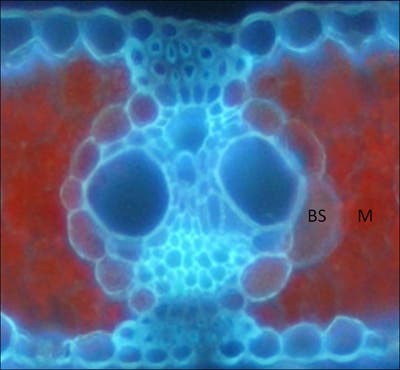Scientists at Cornell University may have stumbled across the cornucopia gene for crops, after scientific investigations revealed that a certain gene allows some plants to photosynthesize 50% more efficient than most common plants, including crops like wheat or rice. The researchers hope through genetic manipulation that they may transfer this gene to crops, allowing for higher yields and an increase in food production destined for an ever demanding and growing population.

The gene is responsible for controlling a special leaf structure called the Kranz anatomy, known to render a better photosynthesis efficiency – the ability to turn energy from light into chemical energy. Typically modern plants today photosynthesize using two methods: the C3 method, employed by most older plants like wheat or rice, and the C4 method, a more efficient adaptation employed by grasses, maize, sorghum and sugarcane that is better suited to drought, intense sunlight, heat and low nitrogen.
It is the latter method that scientists are most interested in because of its higher yield potential for crops, however although the underlying mechanisms that allow for a better efficiency had been known, the genetic markups that code this behavior was a mystery until now. It’s no wonder then that massive efforts and funding has been granted in pursuit of transferring C4 mechanics to C3.
The “Scarecrow” gene
“Researchers have been trying to find the underlying genetics of Kranz anatomy so we can engineer it into C3 crops,” said Thomas Slewinski, lead author of a paper that appeared online in November in the journal Plant and Cell Physiology.
[The finding] “provides a clue as to how this whole anatomical key is regulated,” said Turgeon. “There’s still a lot to be learned, but now the barn door is open and you are going to see people working on this Scarecrow pathway.”
Since C4 plants evolved 60 times more compared to C3, which surfaced at a time in Earth’s history when the atmosphere was more rich in carbon dioxide, the C4 adaptation involves Kranz anatomy in the leaves. This entails an extra layer of bundle sheath cells surrounding the veins and outer layer of the mesophyll – a special tissue key to photosynthesis. The mesophyll cells and extra sheath cells layer work together to form a two-step version of photosynthesis, employing different kinds of chloroplasts.
By using a two-step process, C4 plants first shuttle the products of the photosynthesis reaction in the mesophyll, before delivering them to the bundle sheath for RubisCo – an enzyme that facilitates a reaction that captures carbon dioxide from the air, the first step in producing sucrose, the energy-rich product of photosynthesis that powers the plant. In C3 plants, the RubisCo enzyme also facilitates a competing reaction with oxygen, creating a byproduct that has to be degraded, at a cost of about 30-40 percent overall efficiency. In C4 plants this competing oxygen reaction is minimized to the point of it being eliminated, hence the tremendous 50% jump in efficiency.
The findings were published in the journal journal Plant and Cell Physiology.
[source]


